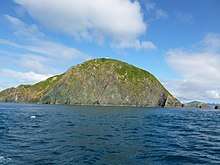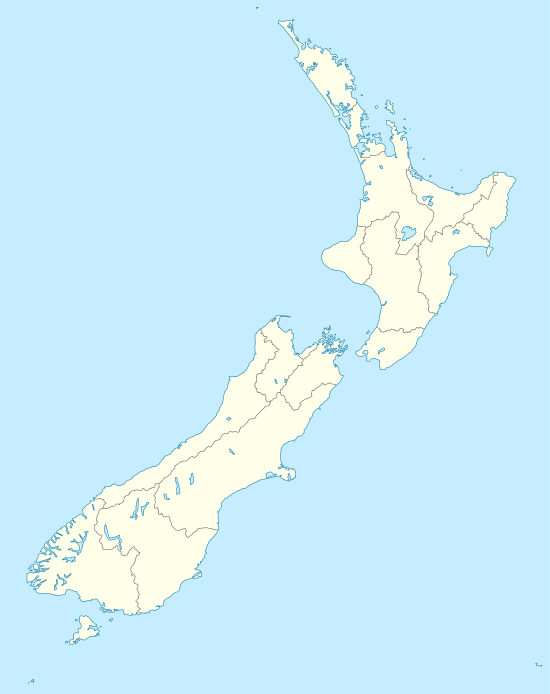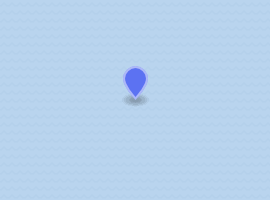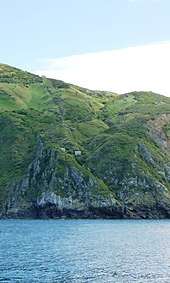Stephens Island Lighthouse
The Stephens Island / Takapourewa lighthouse is one of New Zealand most powerful lights with a range of 18 nautical miles (33 km; 21 mi).[1] Perched 183 metres (600 ft) up, on top of Stephens Island, it guards Cook Strait and Tasman Bay, at the top of the South Island / Te Wai Pounamu.The light flashes white once every six seconds from a white cast iron tower.[2]
 | |
 New Zealand | |

| |
| Location | Northeast of the much larger D'Urville Island
South Island New Zealand |
|---|---|
| Coordinates | 40.40°S 174.00°E |
| Year first lit | 1894 |
| Automated | 1989 |
| Construction | White cast iron tower |
| Tower height | 15 metres (49 ft) |
| Focal height | 183 metres (600 ft) |
| Light source | 50 watt tungsten halogen bulb powered by battery banks charged by solar panels |
| Range | 18 nautical miles (33 km; 21 mi) |
| Characteristic | Flashes white once every six seconds |
| Admiralty number | K4236 |
The light is operated remotely from Maritime New Zealand's Wellington office.[3] It was first lit on 29 January 1894,[4] and did not become automated until 31 March 1989, one of the last in New Zealand to be automated.[5]
Entry to the site and tower is by permit only, because it is part of the Stephens Island Nature Reserve, managed by the Department of Conservation.[6] Today it is home to tuatara, no people and an urban myth about a cat named Tibbles.
Early history

The Māori name for the island, Takapourewa, originates from it once being covered in the takapou trees. Takapou – more commonly known as matipo – trees grew right down to the water’s edge, giving the effect that the island floated in the sea. The Maori word for float is rewa; hence, Takapou-rewa.[7]
In 1770, Captain James Cook sailed by, and named the island after Sir Philip Stephens, the Secretary of the British Admiralty Board.[7]
As the new colony grew in the 1850s, the island was identified as an obvious location for one of a scheme of lighthouses to be erected on significant headlands along New Zealand's 15,000 kilometres (9,300 mi) long coastline.[8] The site was first proposed in 1854, and again in 1888 after the bark Weathersfield was shipwrecked nearby.[1] Several factors, including remoteness, turbulent Cooks Strait and steep terrain, made it a difficult and hazardous to build.[9] In addition, it is the highest elevation above sea level of any lighthouse in New Zealand.[8] Before the lighthouse and associated dwellings could be built, a work party arrived in 1891 to construct a boat landing ledge and vertical tramway up the precipitous cliffs.[10]
The original light components were sourced from Edinburgh[8] and France.[11] The eventual £9,349 cost was twice the price of many other New Zealand lighthouses.[3] Back then, its five wick paraffin lamps made it the brightest lighthouse in New Zealand.[1][3]
The native matipo was cleared to make way for sheep and cattle, and vertical tramway.[12] Habitat destruction and feral cats are blamed for the silencing of birdsong native tui, bellbird and saddle back.[1][10] By way of contrast, when Edward Lukins, a collector of natural history specimens, visited shortly after the occupation, he recorded 31 species of birds, along with two species of land snails and four of lizards.[11]
For the keepers and their families it was a lonely and hard posting, with a perpendicular climb from boat to home. Besides keeping the light lit, they acted as wildlife rangers and coast watchers during the second World War.[8][9] Isolation made illness a serious risk. For example, in May 1909, a doctor and nurse were urgently sent out from Wellington to stifle an outbreak of scarlet fever.[13]
On a brighter note, in 1947, the lighthouse featured on a four pence postage stamp.[5] At one time, there were three keepers and small school.[12] In the mid-1960s, Jeanette Aplin and her family lived on the island for six years. She tells her story in The lighthouse keeper's wife, a tale of self-discovery, small domestic details of a lighthouse community and her zest for isolation from everyday society.[14]
References
- Newport, J. N. W. "Nelson Lighthouses, Nelson Historical Society Journal, Volume 2, Issue 5, November 1971". nzetc.victoria.ac.nz. Retrieved 30 June 2019.
- New Zealand Marine Division. "New Zealand nautical almanac". New Zealand nautical almanac. ISSN 0112-1448. OCLC 11732690.
- "Stephens Island lighthouse - Maritime NZ". www.maritimenz.govt.nz. Retrieved 30 June 2019.
- "By Telegraph". paperspast.natlib.govt.nz. Retrieved 29 June 2019.
- "Stephens Island". www.newzealandlighthouses.com. Retrieved 29 June 2019.
- Rowlett, Russ. "Lighthouses of New Zealand: South Island, The Lighthouse Directory". www.ibiblio.org. Retrieved 29 June 2019.
- "NZGB Gazetteer | linz.govt.nz". gazetteer.linz.govt.nz. Retrieved 29 June 2019.
- "Stephens Island Lighthouse". paperspast.natlib.govt.nz. Retrieved 29 June 2019.
- Baldwin, Olive (1979–1983). Story of New Zealand's French Pass and D'Urville Island. Christchurch City Libraries: Plimmerton [N.Z.] : Fields Publishing House, 1979-1983. ISBN 9780959757712.
- Medway, David G. (2004). "The land bird fauna of Stephens Island, New Zealand in the early 1890s, and the cause of its demise" (PDF). Notornis. 51 (4): 201–211.
- Lukins, Edward (28 October 1894). "Stephen Island, the French Pass and vicinity". paperspast.natlib.govt.nz. Retrieved 2 July 2019.
- Kerr, Alex. "Stephens Island in Nelson Historical Society Journal, Volume 6, Issue 2, 1998". nzetc.victoria.ac.nz. Retrieved 30 June 2019.
- "Scarlatina at Stephen's Island". paperspast.natlib.govt.nz. Retrieved 30 June 2019.
- Aplin, Jeanette (2001). The lighthouse keeper's wife. Auckland, NZ: Cape Catley. ISBN 9780908561872.